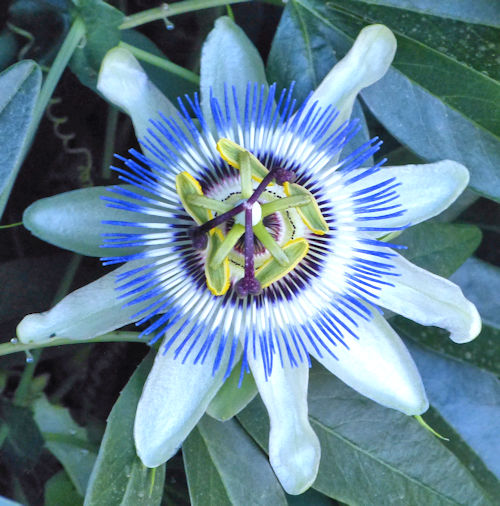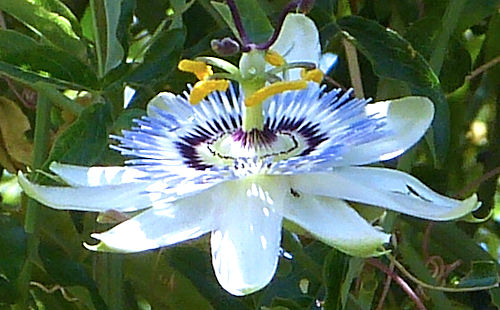Growing Passionfruit and Passionflower:
Passiflora
Back to Fruit, Berries and Nuts
Botanical Overview
A member of the Passionflower family (Passifloraceae), the Passiflora genus has over 500 species, three of which are commonly grown in the desert southwest. Passiflora edulis, Passionfruit Vine, is commercially grown for its fruit. 'Incense' is grown for its fragrant flowers and its good-tasting fruit. Passiflora caerulea, Blue Crown, is one of the most easily grown fruiting ornamentals. Other hybrids are increasingly available.
Description
Form:
Climbing vine.
Lifespan:
3-7 years for Passiflora edulis.
Leaf retention:
Evergreen but frost-deciduous.
Growth rate:
Rapid.
Mature Size:
20-30' (6-9m) long.
Flowers:
An elaborate structure, 3-4" (7.6-10cm) wide, consisting of three stigmatas above (female),
five stamens below (pollen-bearing male), many dozen filaments, with 10 petals and five
green sepals underneath. Each flower lasts only one or two days.
Bloom:
Passiflora edulis: mid-spring into fall and year-round in some locations; 'Incense':
mid-spring through summer; Blue Crown: mid-spring to early summer. Blooming starts further
into summer in northern locations.
Self-fruitful:
Yes except for 'Incense' which needs cross pollination from a second plant. It may be
necessary to hand pollinate any of these species if bees do not find the flowers. The best
time to hand pollinate is about 10am in the morning. Clip off one of the five stamens and rub
the yellow side on the end of each of the three stigmatas.
Years before fruiting:
1.5-2.
Fruit:
Round or ovoid, most often 1.5-3.0" (3.8-7.6cm) wide, a smooth, waxy, leathery rind.
Passiflora edulis has two varieties: the purple ripe fruit belong to P. edulis v. edulis;
the yellow ripe fruit belong to P. edulis v. flavicarpa, Yellow Passion Fruit, and can grow
to 5" (12.7cm) wide. The rind contains aromatic, membranous sacs filled with orange-colored,
uniquely flavorful pulpy juice and many small hard, dark, edible seeds.
'Incense' has flavorful, yellow fruit, edible gelatinous pulp and dark seeds.
Blue Crown has orange fruit with soft, sweet red pulp and seeds that can be mixed with other
fruit or juice for an exotic flavor.
Months for fruit to ripen:
2-3. Passiflora edulis is ripe when ready to fall from the vine. 'Incense' is ripe when
slightly dented or wrinkled. Blue Crown is ripe when fully orange.
Storage after harvest:
Passionfruit continue to ripen after harvest and can be refrigerated in sealed plastic
bags up to 2 weeks.
Leaves:
Green, palmate with three lobes on Passiflora edulis, three or five lobes on 'Incense' and
five fingers on Blue Crown.
Stems:
The vine climbs using tendrils. Stems are herbaceous at first, then become woody with age,
except in regions with winter freezes where they die to the ground and come back from their
roots. No thorns.
Roots:
Shallow, spreading by root suckers, aggressive in moist soils in warm locations.
Passiflora edulis is sometimes grafted onto Passiflora edulis v. flavicarpa rootstock,
which better withstands soil diseases.
Species of Note for hot, dry climates:
Passiflora edulis - grown commercially for juice;
the flowers have yellow-green stigmatas and stamens, purple and white filaments and
white petals.
Passiflora caerulea: Blue Crown - a fruiting
ornamental having fragrant flowers with purple stigmatas, yellow-green stamens, white and
blue filaments, and white petals.
Passiflora x 'Incense' - a fruiting ornamental
having fragrant flowers with white stigmata and stamens, purple filaments, and purple
petals.
Wildlife:
The flowers attract bees, butterflies and hummingbirds. Birds and mammals eat the fruit.
Passionflower and Passionfruit vines are caterpillar hosts for Gulf Fritillary and
Variegated Fritillary butterflies, and occasionally other butterfly species.
Toxic / Danger:
All parts are poisonous except ripe fruit.
Origin:
South America.
Cultivation and Uses
USDA hardiness zones:
Passiflora edulis 8-10, 'Incense' 6b-10, Blue Crown 6-10. The vines die to the ground in
freezing temperatures and come back from their roots in the spring if well mulched.
Chill hours:
None.
Heat tolerant:
Extra water is needed in temperatures over 90°F (32°C).
Drought tolerant:
No. These plants prefer high humidity.
Sun:
Full sun to part afternoon shade. More sun produces more flowers and fruits except in very
high temperatures, when afternoon part shade is necessary.
Planting:
Locate the vine where it can climb on something sturdy and be in full sun, possibly with
afternoon part shade. Whatever it climbs should not be so high that you cannot reach the
top for hand pollination or harvest. It can also be grown in large containers.
Soil:
Well draining, moist, moderate organic content, pH 6.6-7.5 (neutral).
Passiflora species are moderately salt tolerant.
Fertilize:
Use organic fertilizer as a slow-release source of nitrogen. Too much nitrogen reduces
flowering and fruit.
Water after becoming established:
Water weekly when fruiting. Additional water is when temperatures are over 90°F
(32°C).
Insufficient water causes fruit wrinkling and fruit drop. In winter, water less often.
Mulch:
A layer of organic mulch helps moisture retention and reduces heat and cold stress for the
shallow roots.
First Year Care:
Water extensively, but gradually taper off from every two days to weekly to encourage roots
to grow wider and deeper. Provide 50% afternoon shade in the first year.
Prune:
Trim to shape anytime the vine grows out of bounds. Remove dead and damaged vines after the
danger of freezing temperatures has passed. Flowering occurs on new vine shoots.
Litter:
Flower and fruit drop if not harvested. Dead vines and leaves in regions with freezes.
Propagation:
Cuttings, with bottom leaves stripped, and planted 1" (2.5cm) deep in planting mix.
Seed does not breed true and must be planted fresh. Dried seed are usually not viable.
Pests:
Butterfly caterpillars may temporarily defoliate the leaves, but the plant will recover.
Uses:
Ornamental, edible fruit.
Comments
Rating Passionflower fruits by taste from high to low: Passiflora edulis is
best, followed by 'incense', then the eastern North American variety Passiflora incarnata
(Maypop), and finally, Blue Crown.
Do you have additional information or a different experience for these plants that you would like to share? Email info@GardenOracle.com. All contributions are welcome and appreciated.
Do you have additional information or a different experience for these plants that you would like to share? Email info@GardenOracle.com. All contributions are welcome and appreciated.



Flower, fruit and leaves of Passiflora edulis: Passionfruit Vine




Flower, fruit and leaves of Passiflora caerulea: Blue Crown Passion Flower
Latest update: August, 2024
© 2008-2025 by GardenOracle.com

